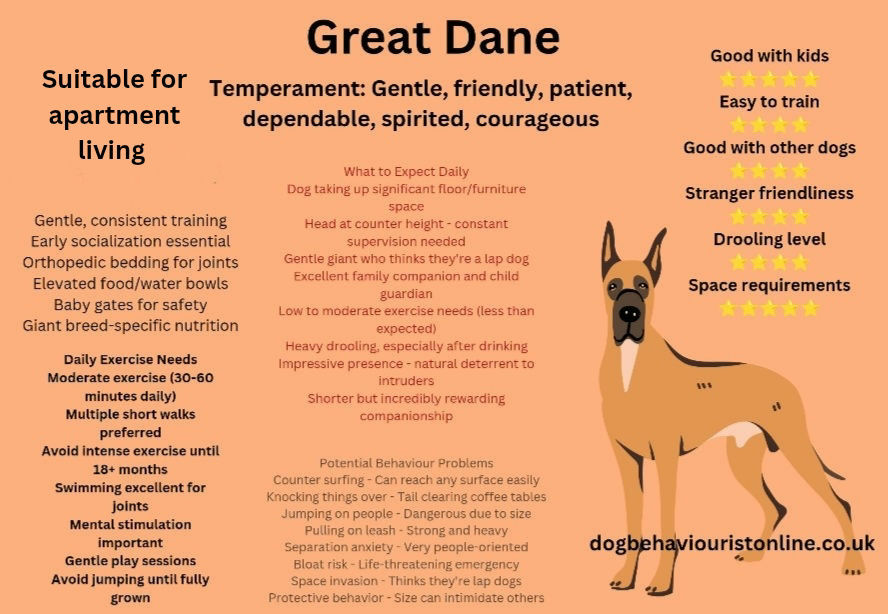Great Dane Training: Mastering the Art of Teaching Gentle Giants
- Aug 17
- 4 min read
Training a Great Dane presents unique challenges that differ significantly from working with smaller breeds. When your puppy will grow to weigh 100–200 pounds and stand over 30 inches tall, every training decision becomes magnified in importance. What might be merely annoying behaviour in a Chihuahua can become dangerous or destructive when performed by a dog the size of a small pony.
In the following sections, this comprehensive guide addresses the specific needs, challenges, and opportunities that come with training one of the world's largest dog breeds.
Understanding the Great Dane Mindset
Despite their imposing size, Great Danes are known as “gentle giants” for good reason. Originally bred in Germany to hunt wild boar and later refined as estate guardians, modern Danes retain the courage and alertness of their working heritage while developing into remarkably affectionate companions.
They are sensitive, intelligent, and eager to please—but also emotionally delicate. Harsh training methods that tougher breeds might shrug off can cause a Dane to shut down or become fearful. They thrive on patient, consistent, positive reinforcement paired with the clear structure they crave.
Another important point: Great Danes mature slowly. Physically, they grow very quickly, but mentally, they may remain “puppy-like” until 18–24 months. This extended puppyhood in a giant body requires extra patience and understanding from their handlers.
The Critical Importance of Early Training
Given the breed's size, early training and consistent routines are essential. A behaviour that's manageable in a small puppy can become problematic in an adult; act early.
Key focuses include:
Basic manners: sitting before meals, polite greetings.
Leash manners: preventing pulling from the start.
Crate and house training: building routines and structure.
Handling exercises: preparing for grooming, vet visits, and daily care.
Early socialisation: exposing the puppy to people, environments, and experiences before 16 weeks.
Positive Reinforcement: The Only Way Forward
Danes respond exceptionally well to reward-based training. Many are food-motivated, but praise, play, and affection can be just as powerful.
Keep sessions short (5–10 minutes).
Reward immediately so they connect behaviour with outcome.
Offer consistent messages and structure throughout training to avoid confusion and help your Dane thrive.
Essential Commands for Great Danes
Some commands are not optional with this breed; they’re essential for safety:
Sit: prevents jumping and teaches calm greetings.
Down: makes their size more manageable.
Stay/Wait: builds impulse control.
Recall (Come): must be taught carefully and reinforced regularly.
Gentle/Easy: moderates enthusiasm during play or when taking food.
Off: teaches them to remove themselves from furniture, people, or counters.
Leash Training: Managing Size and Power
Start early. Use a front-clip harness to avoid damage to their sensitive throat and to redirect pulling. Follow the principle: no pulling = forward progress. If the leash tightens, stop. Consistency is key.
If pulling is already a habit, professional support can be invaluable given the sheer strength of an adult Dane.
House Training Considerations
Use a crate sized for their adult body but divided for puppy use.
Stick to consistent feeding and bathroom schedules.
Supervise closely; accidents are more significant with this breed.
Socialisation: Confidence in a Giant Package
Expose your Dane puppy to a variety of people, places, and situations. Include children, elderly people, mobility aids, and busy environments. Pair new experiences with positive rewards.
For dog interactions, supervise carefully—playful Dane puppies can unintentionally overwhelm smaller dogs.
Managing Adolescence
Between 6–18 months, Danes often test boundaries. Keep training consistent, increase mental stimulation, and guide them through fear periods gently.
Advanced Training and Mental Stimulation
Great Danes enjoy learning beyond the basics. Options include:
Therapy dog training.
Modified agility.
Scent work and puzzle games.
Trick training or advanced obedience.
Special Considerations for Giant Breeds
Joint protection: Avoid repetitive jumping or long-distance running until 18–24 months.
Bloat risk: Never train or exercise heavily right before or after meals.
Equipment: Use wide collars and harnesses designed for deep-chested breeds.
Temperature: Monitor for overheating in summer and reluctance in cold weather.
Common Behaviour Challenges
Jumping: Teach sit for greetings.
Counter surfing: Manage environment and teach “leave it.”
Pulling: Address early; seek help if it’s already established.
Mouthing: Redirect to toys.
Resource guarding: Seek professional guidance immediately.
Working with Professional Trainers
Due to their size and sensitivity, many Great Dane owners benefit from expert help. Choose trainers experienced with giant breeds who use positive reinforcement methods.
👉 Do you need help with your Great Dane? I offer personalised behaviour and training support, from puppy foundations to solving complex problems. Explore my services here.
Long-Term Success
Great Danes need lifelong consistency, ongoing training, and realistic expectations of their slower maturity. When trained well, they are truly gentle giants—adaptable, calm, and devoted companions.
With patience and the right approach, your Great Dane will grow into a polite, affectionate, and well-mannered family member who shows just how rewarding life with a giant breed can be.




Comments